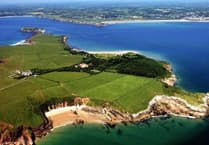‘Ten Historical Figures of Tenby’ was the subject which brought Arts Club members out on Friday. Glyn Harris (pictured) who is the Community Heritage Officer at Tenby Museum and Art Gallery - a position funded by the Enhancing Pembrokeshire Scheme - had chosen characters well-known and less well-known to bring to his local audience.
He started with Henry Tudor who, with his uncle Jasper, is said to have escaped through tunnels underneath Boots the Chemist in the High Street (perhaps stopping to pick up a prescription on the way?) Glyn thought that, exciting though a story it might be, it was much more likely that they could have walked down the street unchallenged.
Next came Robert Recorde, well-known to visitors to St Mary’s Church where there is a large plaque commemorating him and noting that he invented the sign of equality thereby relieving mathematicians of the necessity of writing “is equal to” constantly.
William Paxton, perhaps not a very nice man but one with a great vision for Tenby, and then Peggy Davies who benefitted from the introduction of bathing machines when Tenby became the place to go to restore health. She was a “bathing woman” who assisted nervous ladies who were being immersed in the sea for the first time.
Then came Margaret Jenkins who was the first female mayor of Tenby; Nina Catherine Stokes was notable for her war efforts; Frank B Mason, who was instrumental in getting the Admission of the Press Bill passed by parliament, and finally Gwen and Augustus John and their Bohemian reputation.
There was lively discussion during question time at the end of the talk which continued during tea and biscuits. Chairman Adrian Davies thanked Glyn for his most interesting and informative presentation.
Tonight, October 28, John Archer-Thompson will be talking about the Pembrokeshire Coastal Path. This starts at 6pm at St John’s Church Hall in Warren Street and all are most welcome. Admission fee includes tea/coffee and biscuits, and members enjoy a discount.




